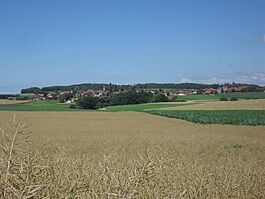Combremont-le-Grand facts for kids
Quick facts for kids
Combremont-le-Grand
|
|
|---|---|
 |
|
| Country | Switzerland |
| Canton | Vaud |
| District | Broye-Vully |
| Area | |
| • Total | 6.61 km2 (2.55 sq mi) |
| Elevation | 674 m (2,211 ft) |
| Population | |
| • Total | 302 |
| • Density | 45.69/km2 (118.33/sq mi) |
| Postal code |
1535
|
| Surrounded by | Champtauroz, Cheiry (FR), Combremont-le-Petit, Nuvilly (FR), Sassel, Treytorrens (Payerne) |
Combremont-le-Grand used to be a small town, or municipality, in Switzerland. It was located in the canton of Vaud. This area is known as the Broye-Vully district.
On July 1, 2011, Combremont-le-Grand joined with several other towns. These towns were Cerniaz, Combremont-le-Petit, Granges-près-Marnand, Marnand, Sassel, Seigneux, and Villars-Bramard. Together, they formed a brand new municipality called Valbroye.
Contents
A Look Back: History of Combremont-le-Grand
The town of Combremont-le-Grand has a long history. It was first written about way back in the year 911. Back then, it was called Cumbromo. Later, in 1142, its name changed to Combremont.
Where is Combremont-le-Grand?
Combremont-le-Grand covers an area of about 6.6 square kilometers (about 2.5 square miles). Most of this land is used for farming. About 75% of the area is farmland. Another 20% is covered by forests. The rest, about 5%, has buildings and roads.
The town is located along the road that connects Payerne and Thierrens. Until 2006, it was part of the Payerne District. After that, it became part of the newer Broye-Vully district.
Town Symbol: The Coat of Arms
Every town often has a special symbol called a coat of arms. It's like a unique badge for the town. The coat of arms for Combremont-le-Grand is described as: Sable, a Greyhound rampant Or langued Gules and gorged Argent.
This means it shows a black shield (Sable). On the shield, there is a golden greyhound dog standing on its hind legs (rampant Or). The dog has a red tongue (langued Gules) and a silver collar around its neck (gorged Argent).
Who Lives There? Population Facts
In 2009, Combremont-le-Grand had a population of 302 people. Most people in the town speak French. About 93% of the residents speak French. A smaller number speak German (almost 5%) or Portuguese (about 1%).
Many people who live in Combremont-le-Grand were also born there. In 2000, about half of the residents were born in the town itself. Others were born elsewhere in Switzerland or in other countries.
The town has a mix of age groups. In 2009, about 10% of the population were children aged 0-9. Teenagers (10-19 years old) made up about 14%. Adults aged 20-59 made up a larger part, around 55%. About 20% of the population were seniors, aged 60 and above.
The historical population of Combremont-le-Grand has changed over time:

Note: The "21 Hearths" in 1432 means there were 21 households that paid a special tax called a hearth tax. This tax was based on the number of fireplaces (hearths) a home had. It helped show how many families lived there.
Jobs and Economy
In 2010, the unemployment rate in Combremont-le-Grand was very low, at 1.2%. This means most people who wanted to work had jobs.
Many people in the town work in the primary sector. This mainly means jobs like farming. There are also some jobs in the secondary sector, which includes things like manufacturing and construction. The tertiary sector includes jobs that provide services. These can be things like selling cars, working in restaurants, or providing healthcare.
Religious Beliefs
In 2000, most people in Combremont-le-Grand belonged to a Christian church. About 72% were part of the Swiss Reformed Church. Around 18% were Roman Catholic. A small number of people belonged to other Christian churches or were Islamic. Some people did not belong to any church.
Learning and Schools
Education is important in Combremont-le-Grand. Many adults have finished high school. Some have even gone on to higher education, like university.
In the 2009/2010 school year, there were 43 students in the local school district. The canton of Vaud, where Combremont-le-Grand is located, offers two years of optional pre-school. There were 16 students in the primary school program. The lower secondary school program had 27 students.



